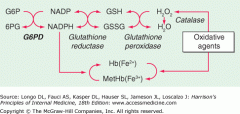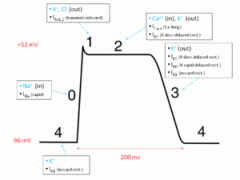![]()
![]()
![]()
Use LEFT and RIGHT arrow keys to navigate between flashcards;
Use UP and DOWN arrow keys to flip the card;
H to show hint;
A reads text to speech;
31 Cards in this Set
- Front
- Back
|
Hypospaidas
|
-in males, incomplete fusion of urethral (urogenital) folds results in hypospadias
-hypospadias is abnormal opening of urethra proximal to glans penis, along ventral shaft of penis |
|
|
Epispadias
|
-less common than hypospadias
-urethral opening on dorsal side of penis -due to faulty positioning of genital tubercle |
|
|
Total flow
|
total flow = flow velcoity x cross sectional area = constant
i.e., Q = A1V1 = A2V2 |
|
|
Classic galastosemia
|
-autosomal recessive disease
-patients with galactosemia are homozygous for a defective galactose-1-phosphate uridyltransferase gene -in general, most enzyme deficiencies follow autosomal recessive inheritance --vs. most diseases due to defective non-catalytic proteins follow autosomal dominate pattern |
|
|
C. perfringens
|
-clostridium = gram-positive rod
-causes late-onset food poisoning and clostridial myonecrosis (gas gangrene) -the food poisoning is toxin-mediated, late-onset, and clinically causes transient watery diarrhea |
|
|
Maple syrup urine disease
-presentation: vomiting, irritability, lethargy, and diapers that smell like "burned sugar" |
-Maple syrup urine disease (MSUD) is disorder due to defective breakdown of branched chain amino acids – leucine, isoleucine, valine.
-degradation of these amino acids involves transamination to their respective alpha-ketoactids, which are then metabolized by an enzyme complex called BRNACHED-CHAIN ALPHA-KETOACID DEHYDROGENASE -this enzyme (like pyruvate dehydrogenase) requires "tender loving care for nancy" --coenzymes: thiamine pyrophosphate, lipoate, coenzyme A, FAD, NAD --some patients with maple syrup urine disease improve with high-dose thiamine treatment (thiamine-responsive), but most still require lifelong dietary restrictions |
|
|
Patent ductus arteriosus
|
-characterized by continuous murmur, heard best in left infra-clavicular region, with maximal intensity at S2
-small PDA is often asymptomatic – usually detected incidentally -PDA most common in patients born prematurely, and those with cyanotic congenital heart disease (PDA = shunt) |
|
|
Atrial septal defect
|
-much less common than a PDA
-can cause continuous murmur in rare instances – usually when associated with mitral valve obstruction due to an elevated pressure gradient across the atria (Lutembacher syndrome) |
|
|
Hyper-osmotic volume contraction
|
-volume contraction or expansion can be classified as iso-osmotic, hypo-osmotic, or hyper-osmotic.
-loss of free water with retention of electrolytes is seen in diabetes insipid us, and in excessive seating without fluid and solute replacement. --these are examples of hyper-osmotic volume contraction (loss of fluids, with rise in serum osmolarity) |
|
|
Hibernating myocardium
|
-repetitive ischemia or persistent hypo perfusion of myocytes can result in chronic but REVERSIBLE loss of contractile function – known as "hibernation"
-persistent or repetitive low flow state causes myocardial hibernation – can be reversed by re-perfusion |
|
|
Myocardial stunning
|
-less sever form (than hibernating myocardium) of ischemia-induced reversible loss of contractile function
--repetitive stunning can result in hibernation |
|
|
Ischemic preconditioning of myocardium
|
-ischemic preconditioning = development of resistance to infarction by cardiac myocytes previously exposed to repetitive non-lethal ischemia
|
|
|
Ventricular remodeling
|
-ventricular remodeling involves chronic changes in mass, volume, shape, and myocyte composition of the heart – compensates for increased hemodynamic load
|
|
|
Lesions involving CN 3
|
-CN 3 lesions cause ptosis (drooping upper eyelid), downward and laterally deviated eye, impaired pupillary constriction and accommodation, and diagonal diplopia (vertical and horizontal diplopia)
-most dreaded causes of CN 3 palsy is an enlarging intracranial aneurysm |
|
|
Azithromycin for Mycobacterium avium
|
-mycobacterium avium is a common opportunistic pathogen that causes disseminated disease (mycobacterium avium complex, MAC) in HIV-positive patients
-weekly AZITHROMYCIN is used as prophylaxis in patients at risk for MYAC --e.g., HIV+ patients with CD4 counts less than 50 cells/mL |
|
|
Bell's palsy symptoms
|
-in addition to unilateral facial paralysis, patients with Bell's palsy may experience decreased tearing, hyperacusis (sensitivity to volume), and/or loss of taste sensation in ANTERIOR 2/3 OF TONGUE
|
|
|
Posterior tongue taste
|
-glossopharyngeal nerve (CN 9) provides taste sensation from posterior 1/3 of tongue
-vs. facial nerve (CN 7) provides taste from anterior 2/3 of tongue. |
|
|
G6PD deficiency, vs. glutathione reductase deficiency
|

-glucose 6-phosphate dehydrogenase deficiency is defect in HMP shunt that impairs glutathioine reduction, due to failure to produce NADPH
-glutathione reductase deficiency causes similar clinical picture, due to similar patho-physiology |
|
|
Anorexia nervosa
|
-most common eating disorder in adolescent girls from affluent families
-criteria include: --body weight at least 15% below normal, with refusal to maintain normal weight --amenorrhea for three months --distorted body image (views self as obese) --fear of gaining weight despite being underweight -FEMALE ATHLETE TRIAD often seen with anorexia nervosa: --eating disorder --amenorrhea --osteoporosis |
|
|
-Rubeola virus presentation
-CCCK |
-tetrad of cough, coryza (nasal inflammation/congestion), conjunctivitis and Koplik spots is diagnostic of measles (rubeola)
-Koplik spots are tiny white or blue-gray lesions on buccal mucosa that precede the maculopapular skin rash |
|
|
Th2 cells and isotope switching
|
-Sensitized Th2 cells secrete IL-4 and IL-13 – together promote B-lymphocyte class switching for IgE synthesis
-also secrete IL-5, which activates eosinophils and promotes IgA synthesis -excess of these Th2-produced lymphokines may contribute to pathogenesis of extrinsic allergic asthma |
|
|
IL-1
|
-secreted by macrophages to stimulate helper T-cells
|
|
|
IL-3
|
-secreted by helper T cells to recruit bone marrow stem cells
|
|
|
gamma-interferon
|
-secreted by helper T cells, mainly to activate macrophages
|
|
|
TGF-beta
|
-growth factor involved in tissue regeneration and repair
|
|
|
Dofetilide action
-K+ blocker (class 3 anti-arrhythmic) |

-class 3 anti-arrhythmic agents block potassium efflux from cardiac myocytes
--slow potassium efflux from cardiac myocyte --prolong PHASE 3 of myocyte action potential |
|
|
ACE inhibitors and first-dose hypOtension
|
-first-dose hypotension is an adverse effect when initiating ACE inhibitors
--predisposing risk factors for first-dose hypotension include hyponatremia, hypovolemia (secondary to diuretics), low baseline blood pressure, high renin or aldosterone levels, renal impairment, and heart failure. --patients taking thiazide or loop diuretics can be hypovolemic and hyponatremic, thus potentiating the effects of first-dose hypotension -to minimize risk for first-dose hypotension, initiate low dosages to at-rsk patients, and proceed with cautious dosage titration and BP monitoring |
|
|
Amiodarone and thyroid function
|
-amiodarne is a class 3 anti-arrythmic drug
-used to suppress life-threatening cardiac conduction abnormalities -thyroid function tests should be monitored in patients receiving amiodarone therapy -amiodarone is associated with many side effects: --thyroid dysfunction --corneal micro-deposits --blue-gray skin discoloration --drug-related hepatitis --pulmonary fibrosis |
|
|
Epithelium of respiratory tract
|
-psuedostratified columnar mucus-secreting epithelium:
--nose, paranasal sinuses, nasopharynx, most of larynx, and tracho-bronchial tree -Stratified squamous epithelium: --found only in oropharynx, laryngopharynx, anterior epiglottis, upper half of posterior epiglottis, and VOCAL FOLDS (true vocal cords) |
|
|
Suarachnoid hemorrhage
|
-sub-arachnoid hemorrhage presents with generalized excruciating headache ("worst headache of my life")
-usually occurs due to rupture of saccular (berry) aneurysms, or arteriovenous malformations -berry aneurysms of circle of Willis are associated with autosomal dominant polycystic kidney disease |
|
|
Sarcoidosis
|
-sarcoidosis most commonly affects young black women
-presents with malaise, cough, varied cutaneous finding (including erythema nodosum) -chest X-ray shows BILATERAL HILAR LYMPHADENOPATHY -trans-bronchial biopsy with NON-CASEATING GRANULOMAS is necessary for diagnosis |

